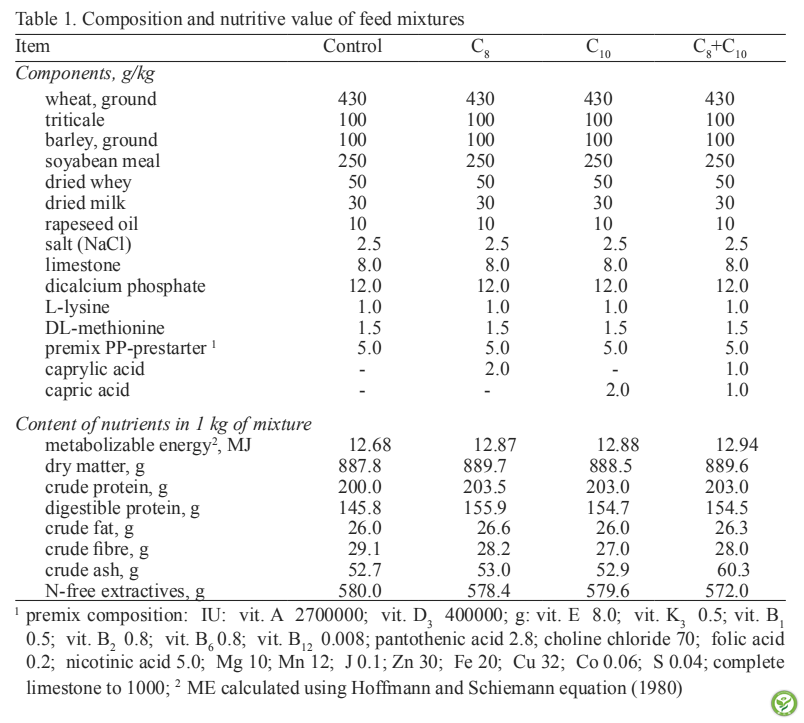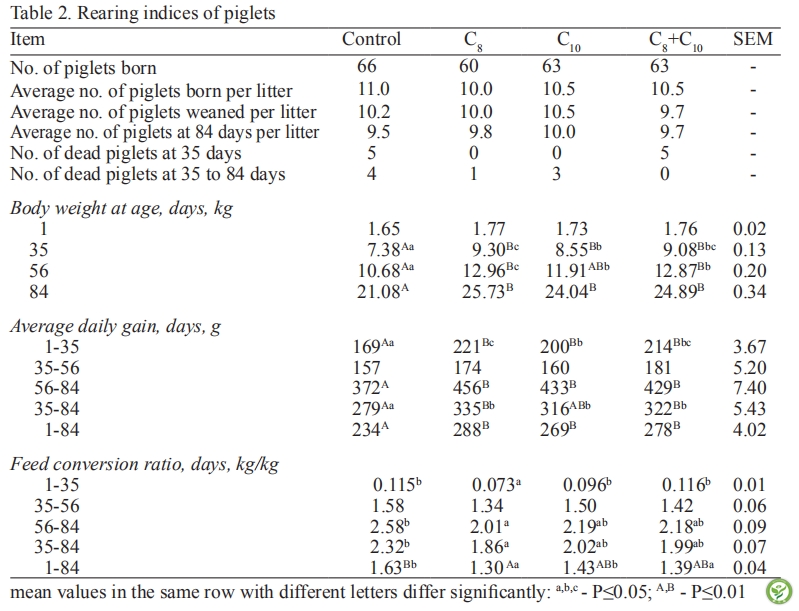Effects of dietary caprylic and capric acids on piglet performance and mucosal epithelium structure of the ileum
作者:E. Hanczakowska1,3, A. Szewczyk1 and K. Okoń2
1National Research Institute of Animal Production, Department of Animal Nutrition and Feed Science32-083 Balice, Poland
2Medical College Jagiellonian University, Department of Pathomorphology
Grzegórzecka 16, 31-531Kraków, Poland
来源:Journal of Animal and Feed Sciences, 20, 2011, 545–554
DOI: 10.22358/jafs/66213/2011
翻译:肠动力研究院 梁琦
【摘要】本文探究了日粮中添加辛酸和/或癸酸对仔猪生产性能、营养素的表观消化率、肠道菌群和小肠(回肠)结构的影响。该研究使用252头仔猪(24窝),分成4个实验组(每组6窝)。实验分组如下:对照组(仔猪喂食标准饲料混合物);C8组或C10组(对照日粮的基础上,每1kg饲料添加2g辛酸或癸酸);C8+C10组(对照日粮的基础上,添加1g辛酸和1g癸酸)。Cr2O3作为指示剂来估计表观消化率,标准琼脂平板则用来进行微生物分析。Varian 340分析仪用来分析回肠和盲肠食糜的短链脂肪酸(SCFA)含量。实验结果显示:日粮中添加辛酸或癸酸的仔猪的平均日增重与对照组仔猪相比差异显著(P <0.01)(在整个实验期间,即在第1-84天之间的平均日增重分别为:288,269和234g)。研究发现:饲喂辛酸的仔猪具备最佳的饲料利用率(1.3kg/kg)。这些酸(辛酸和癸酸)降低了仔猪的死亡率,同时显著提高了蛋白质的消化率(P <0.01),且在较小程度上(P <0.05)也提高了纤维的消化率。对照组和实验组仔猪的食糜酸度没有显著差异。与对照组相比,癸酸增加了需氧菌的数量,但是大肠杆菌的数量却保持不变。辛酸和癸酸则显著减少了产气荚膜梭菌的数量(P <0.01)。尽管这些酸对回肠的SCFA含量没有影响,但降低了盲肠食糜的乙酸含量。其中癸酸对小肠绒毛的影响最大(306μm),其显著高于对照组(233μm)。4组实验组仔猪的隐窝深度差异较小,但饲喂癸酸的仔猪隐窝是最深的。研究结果表明:日粮中添加辛酸和癸酸能够提高仔猪的生产性能,究其原因可能是仔猪的回肠粘膜上皮结构发生了有益的变化。
【关键词】中链脂肪酸;辛酸;癸酸;回肠上皮结构;饲料改良;仔猪
以下是实验中相关图表
表1:饲料混合物的组成和营养价值

表2:饲养仔猪的指数

表3:营养素的表观消化率,%(基于每组4窝仔猪)

表4:胃和肠道各部的食糜的酸度(基于每组6头仔猪)

表5:小肠(回肠)食糜的微生物数量,log10CFU/(1 g食糜)(基于每组6头仔猪)

表6:仔猪回肠和盲肠食糜中短链脂肪酸(SCFA)的含量,μmol/1 g食糜(基于每组6头仔猪)

表7:回肠粘膜上皮结构(基于每组6头仔猪)

结论
本实验的结果表明:中链脂肪酸(辛酸和癸酸)能够提高仔猪的生产性能和蛋白质的消化率。辛酸对仔猪死亡率和平均日增重具有最有益的作用。两种酸(辛酸和癸酸)引起的积极变化可归因于小肠粘膜的结构变化和肠道菌群的变化。
Abstract
Effects of a diet supplemented with caprylic and/or capric acid on piglet performance, apparent digestibility of nutrients, intestinal microflora and small intestine (ileum) structure were investigated. The experiment was performed on 252 piglets (24 litters) allocated to 4 experimental groups (6 litters each). The animals were fed with a standard feed mixture (control) or the same mixture supplemented with 2 g of caprylic or capric acid (groups C8 and C10, respectively) per 1kg of feed. Group C8+C10 received 1 g of caprylic and 1 g of capric acid. Apparent digestibility was estimated using Cr2O3 as an indicator, while microbiological analyses were performed using standard agar plates. The short-chain fatty acid (SCFA) content of the ileum and caecum digesta was analysed using Varian 340 analyzer. The piglets receiving caprylic or capric acids grew significantly (P<0.01) faster than the control ones (average daily gains during the whole experiment, i.e. between days 1 and 84 of age, were: 288, 269 and 234 g, respectively). The best feed utilization (1.3 kg per kg) was found in animals receiving caprylic acid. The acids also lowered piglet mortality, while significantly increased protein digestibility (P<0.01) and, to a lesser degree (P<0.05), also fibre digestibility. There was no significant difference in acidity of the digesta between control and experimental groups. Capric acid increased the amount of aerobic bacteria as compared to the control group, but the amount of Escherichia coli remained unchanged. The population of Clostridium perfringens was reduced by both caprylic and capric acids (P<0.01). Acids had no effect on SCFA content of the ileum but lowered the acetic acid content of the caecum digesta. Capric acid had the strongest effect on villi, which were significantly higher (306 μm) than in the control group (233 μm). Differences in crypt depth were smaller but the crypts were also the deepest in piglets receiving capric acid. The results suggest that caprylic and capric acids added to the feed improve piglet performance, probably due to positive changes in the mucosal epithelium structure of the ileum.
KEY WORDS: medium-chain fatty acids, caprylic acid, capric acid, ileum epithelium structure, feed improvement, piglets
Conclusion
Results of the present experiment indicate that medium-chain fatty acids, caprylic and capric, improve piglet performance and protein digestibility. Caprylic acid has the most beneficial effect on piglet mortality and weight gain. The improvement caused by both acids can be due to structural changes of the small intestine mucosa and changes in the bacterial population.
如您需原文,请联系本文作者和出版方,或请垂询肠动力研究院。本网站发布的所有资料将尽最大可能注明出处、作者及日期,如无意中侵犯了您的知识产权,请来信及时告知,我们将立即予以删除。
All information released by the WeChat Official Account will do its best to indicate the source, author and date. If we inadvertently infringe on your intellectual property, please inform us in time and we will delete it immediately.






